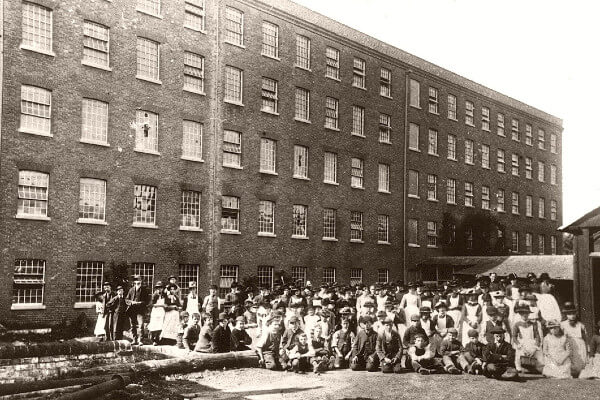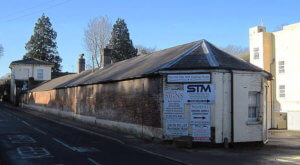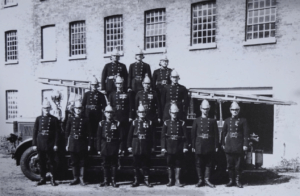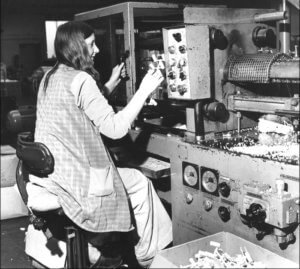Hive of Local Industry

Tring’s Silk Mill is now a hub for small local businesses, but in its past life it has produced silk, electricity, plane parts – and even lipstick cases!
Today, Silk Mill in Tring is a hub for local businesses including a martial arts centre and winery, but its history begins, as its name suggests, with a very different local industry.
The Silk Mill was the brainchild of William Kay, the son of a yeoman farmer from Cumberland, who had made his fortune from the textile trade in Manchester. He later moved to London and, in 1823, bought the Tring Park Estate. As well as the mansion and parklands, the estate included a water-driven corn mill. He never lived in the mansion, instead letting it out to various tenants – including Nathan Rothschild.
A year after buying the estate, the five-storey Silk Mill building was underway – along with a row of cottages in Brook Street. The project, which William claimed cost £30,000, was managed by William’s brother Joseph – and the locals dubbed the new development ‘Little Manchester’. Once the business was up and running, four years later it was leased to a company belonging to David Evans, while both brothers retained financial interest in the business.
Around the same time, Tring was growing apace – new houses appeared on the western side of the town and the Butcher family founded a bank. It was also around this time that John Brown moved to Tring from Dorset, buying a brewery and building pubs. Many families earned extra money by plaiting straw for the Luton hat trade.
The five-storey building had a warehouse on each floor, and the ground floor included a dining room for workers. Senior members of staff were provided with accommodation – the manager with a large house and garden. There was also a lodge house and cottage, stables for horses, a smith’s house and forge, and a coach house.
The number of workers varied depending on the demand for silk and the agricultural season. At one time in 1840 there were 140 women, 320 children and 40 men employed.
Children were hired at an early age, as the manager wanted those who did not have rough hands. Interestingly, girls were more valued than boys, thanks to their nimble fingers and willingness to obey orders – and earned threepence a week more than their male counterparts!
 Children from workhouses (usually Berkhamsted, as the Tring workhouse children were employed in the straw plaiting industry) were apprenticed to the Mill – and the young workers were housed in five cottages in front of the Mill, which became a dormitory, supervised by the Master and Matron. The dormitory was inspected regularly by the Board of Governors from St. Margaret’s and St. George’s workhouses in London. Child labour protection laws brought in by Factory Acts in the 1830s and 40s didn’t apply to the silk trade, and it would be another 20 years before children working in the industry would be afforded the same protection.
Children from workhouses (usually Berkhamsted, as the Tring workhouse children were employed in the straw plaiting industry) were apprenticed to the Mill – and the young workers were housed in five cottages in front of the Mill, which became a dormitory, supervised by the Master and Matron. The dormitory was inspected regularly by the Board of Governors from St. Margaret’s and St. George’s workhouses in London. Child labour protection laws brought in by Factory Acts in the 1830s and 40s didn’t apply to the silk trade, and it would be another 20 years before children working in the industry would be afforded the same protection.
Though not exciting fare by today’s standards, they had a good food allowance including bread and milk for breakfast, meat and vegetables four days a week, along with soup, rice pudding and suet pudding and cheese.
Children under 11 were supposed to work seven hours a day with an additional three hours of schooling. Whether that happened or not is unclear…
Sadly it was not a very happy life. One child who worked at the Mill and escaped to seek his fortune in London, where he became a Chartist poet, editor and writer, said that he had ‘no childhood at all’. Gerald Massey (known as ‘Tring’s Poet’) was born at Gamnel Wharf in Tring and was sent to work in the Mill at the age of eight, working 12-hour days with a reward of between nine pence and one shilling and three pence. He later worked in Tring’s straw plaiting industry. He was also the model for George Eliot’s The Radical. The Gerald Massey Poetry Competition commemorates him, and is open to students at Tring School. The flats opposite the Silk Mill also remember him in their name – Massey House.
The silk skeins worked on at Tring Silk Mill came from China, Italy and Bengal – and once prepared would be sent to David Evans’ Aylesbury weaving factory or to mills located in the North. While the mill itself offered reasonable working conditions, with adults working 12 hours a day and children 10, the Tring workforce was constantly troubled by what was known as ‘ague’ or fevers, thought to be caused by stagnant water beneath the building and the mill pond close by.
By 1881, the census recorded that 212 people in Tring had silk-related occupations.
 David Evans also installed a steam engine at the site, to augment the power from the water wheel. He set up a small weaving operation in Akeman Street and later bought land in Brook End and built 22 cottages. The Mill suffered two serious fires in 1836 and 1842 – but luckily Evans was a prudent man and had in place adequate insurance, which allowed the Mill to be up and running again in both instances. According to a report in the Bucks Herald, two fire engines came from Aylesbury, two from Tring, along with private engines provided by Lady Bridgewater and Mr Hay. After the second fire, the Parish of Tring’s fire engine was moved to the site so that it could be close by if such an event occurred again.
David Evans also installed a steam engine at the site, to augment the power from the water wheel. He set up a small weaving operation in Akeman Street and later bought land in Brook End and built 22 cottages. The Mill suffered two serious fires in 1836 and 1842 – but luckily Evans was a prudent man and had in place adequate insurance, which allowed the Mill to be up and running again in both instances. According to a report in the Bucks Herald, two fire engines came from Aylesbury, two from Tring, along with private engines provided by Lady Bridgewater and Mr Hay. After the second fire, the Parish of Tring’s fire engine was moved to the site so that it could be close by if such an event occurred again.
To power the machinery for the Mill, William diverted the Dundale and Miswell streams, in order to create a mill pond – all the work was carried out by men by hand with pickaxes. The water then was sent into the stream in Brook Street, some of which went onto the Wendover arm of the Grand Union Canal and some ended up at Wormwood Lake – now the Tringford Reservoir.
David Evans died in 1874 and the business passed to his three sons. But the building of the Suez Canal meant that getting silk from the Far East was far easier, and the demand for silk from England lessened. Eventually, the management asked Lord Rothschild to be released from the lease. David Evans’ other concerns continued – and the David Evans Crayford silk printers in Kent didn’t close until 2001.
It was not only the Silk Mill that William Kay brought to the town – as the largest local landowner, he presented to the inquiry into the London & Birmingham Railway, and his case (along with a financial contribution from him and other local businessmen) resulted in the station being located not at Pitstone Green as originally planned, but in Tring. He also made a contribution to the road running from the station to the town. Unfortunately he died in 1838, not long after the railway reached Tring. You can find a tablet to his memory in Tring Parish Church, St Peter and St Paul. The Tring Estate was bought by Lionel Nathan Rothschild in 1872.
When Lord Rothschild took over the Mill, he treated workers with his customary benevolence – there are reports of Christmas parties and gifts of ‘appropriate’ and ‘useful’ clothing – and when the Mill closed in 1898, older workers received a pension, while younger men were offered paid passage to start a new life in Canada.
The site was taken over by the maintenance departments from Tring Park, with the water wheel being used to drive a saw-mill and a generator that supplied electricity. The power supplied Tring Park mansion, as well as the estate’s farm buildings and the Rothschild laundry on St Peter’s Hill. It was during the Rothschild’s ownership that the top two storeys of the building were removed.
As World War II approached, the mill site was being used as barracks for the Dorset Regiment. It was then leased by the Minister for Aircraft Production, painted in camouflage colours and used by RMR Engineering to produce torpedo detonators and aluminum alloy and brass sand castings for aircraft components including the De Havilland Comet.
 Once peacetime was established, the factory switched to fabricating bus-ticket machines and cosmetic containers for companies such as Coty, Max Factor, Ponds, and Elizabeth Arden. By the early 50s, Tring was sending out 188,000 lipstick cases a week! When RMR engineering was bought out, and planning refused for a new warehouse nearby, the company left Tring.
Once peacetime was established, the factory switched to fabricating bus-ticket machines and cosmetic containers for companies such as Coty, Max Factor, Ponds, and Elizabeth Arden. By the early 50s, Tring was sending out 188,000 lipstick cases a week! When RMR engineering was bought out, and planning refused for a new warehouse nearby, the company left Tring.
The Silk Mill building is Grade II listed and now houses a number of small businesses, including the Tring Martial Arts Black Belt Academy, Tring Winery, Beginners Quilt Emporium, The Spectacle and Sunglass Store, Le Tarot Spices, Enoch & ChaCha, Loveleigh Aesthetics, and Physique Fitness.
If you want to learn more about the site’s history, seek out the excellent book, The Tring Silk Mill, by Wendy Austin.
With thanks to Tring & District Local History Society
John Bly: ‘Just received the Autumn Tring Living and I write to say congratulations. It is always good but this one is top quality, informative and enjoyable all the way through. Love the article on the Silk Mill!’

